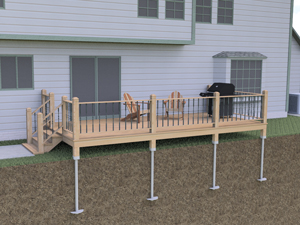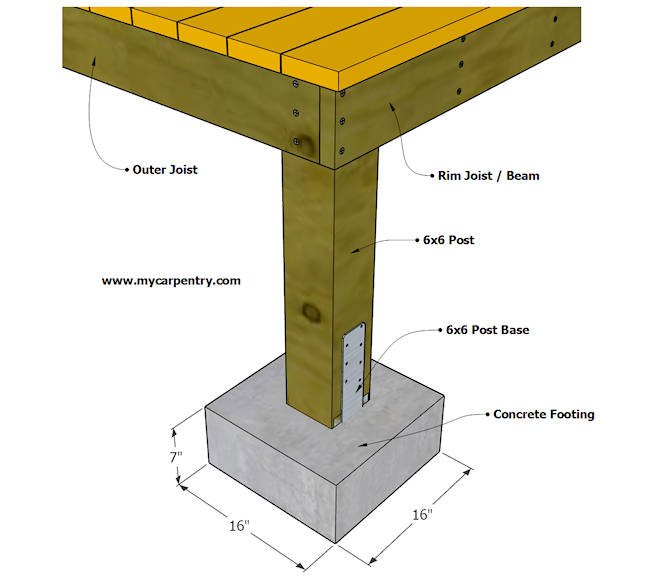Picking the Right Deck Footings for Security and Resilience
When it involves constructing a deck, among the most crucial choices you will certainly make is picking the ideal footings for security and sturdiness. The long life and security of your deck depend greatly on the type of footings you choose, as they supply the crucial support and security to stand up to the test of time. With a myriad of options readily available, it can be frustrating to determine which footings are best fit for your specific demands. In this discussion, we will discover the different types of deck grounds, consider the essential variables to evaluate when making a decision, and dig right into the advantages and disadvantages of various alternatives. By the end, you will have a clearer understanding of the selections available and be better furnished to make an informed decision for your deck job.
Kinds Of Deck Grounds
There are numerous sorts of deck grounds that can be used, each offering one-of-a-kind benefits and factors to consider. One usual type of ground is the concrete pier footing. These grounds contain a cylindrical hole loaded with concrete, which supplies a strong structure for the deck blog posts. Concrete pier grounds are fairly simple to set up and offer superb stability, making them a prominent selection for several deck tasks.
These footings are mounted by screwing them into the ground, which develops a secure structure for the deck. They likewise enable for easy change and progressing of the deck if required.
Alternatively, some contractors go with precast concrete footings. These grounds are constructed from long lasting concrete and be available in different sizes and shapes to accommodate various deck designs. Precast concrete grounds are hassle-free to set up and offer a secure base for the deck framework.
Finally, an additional option is the post-in-anchor footing system. This kind of ground includes driving a metal support right into the ground and attaching it to the deck blog post. It uses flexibility in terms of positioning the deck posts and appropriates for decks with light-weight structures.
When picking the best type of deck ground, it is necessary to think about aspects such as dirt problems, deck tons, and local building ordinance (Deck Footings). Consulting with an expert service provider or structural designer can help make sure the ideal footing is chosen for a safe and secure deck
Variables to Consider When Picking Grounds
When choosing the appropriate footings for a deck, it is important to meticulously consider numerous factors such as soil conditions, deck lots, and adherence to regional building regulations. These variables play a considerable function in guaranteeing the security and resilience of the deck framework.
One of the primary aspects to take into consideration is the soil conditions. The sort of dirt on which the deck will certainly be built establishes the type of footings needed. Decks developed on loosened or sandy dirts may need deeper grounds to supply sufficient support and avoid settling. On the other hand, decks constructed on clay or extensive soils might call for footings that can suit the soil's tendency to increase and contract.
One more crucial aspect is the deck load. The weight of the deck, consisting of the products used and any type of possible live lots such as furniture or events, need to be thought about when selecting footings. The grounds should be created to birth the weight of the deck and distribute it evenly to stop any architectural concerns or failings.
Last but not least, adherence to local building codes is paramount. Building codes vary from region to region, and it is vital to adhere to the certain needs established by the local authorities. Deck Footings. These codes guarantee that the deck is developed securely and fulfills the necessary criteria for structural honesty and load-bearing ability
Concrete Grounds: Cons and pros

Concrete grounds provide numerous benefits and disadvantages when made use of as the structure for a deck. On the positive side, concrete grounds supply excellent security and sturdiness.
Another benefit of concrete grounds is their flexibility. They can be poured right into different shapes and sizes to accommodate various deck styles and setups. Concrete footings can be tailored to fit the certain requirements and requirements of the deck framework.
Nevertheless, there are likewise some disadvantages to making use of concrete grounds. This can increase the overall price of the deck job and may call for specialist assistance.

Helical Piers Vs. Sonotubes: Which Is Better?
In taking into consideration the foundation alternatives for a deck, the comparison between helical piers and sonotubes is crucial in determining the remarkable option. Helical piers, likewise referred to as screw piles, are steel shafts with helical plates connected to them. They are turned into the ground utilizing hydraulic equipment, giving a steady and sturdy foundation for the deck. On the other hand, sonotubes are round kinds made of cardboard or fiber material that are full of concrete. They are positioned in a hole explored the ground and provide assistance for the deck.
The helical plates on the piers develop a solid grasp with the soil, protecting against any type of movement or moving of the deck. Sonotubes, on the various other hand, depend exclusively on the concrete filling up for security, which might not offer the same degree of stamina and resistance.
In terms of installation, helical piers are reasonably less complicated and faster to set up contrasted to sonotubes. The hydraulic machinery used to twist the piers into the ground ensures a effective and fast procedure. Sonotubes, on the other hand, require excavating holes and their website pouring concrete, which can be labor-intensive and taxing.
In addition, helical piers are an even more versatile alternative. They can be used in numerous soil conditions and can be readjusted or enhanced you can check here if needed. Sonotubes, on the other hand, may require extra assistance, such as rebar, in particular soil problems or locations with high load requirements.
Picking the Right Footings for Your Deck's Measurements
For ideal architectural stability, it is important to meticulously select the ideal grounds that straighten with the measurements of your deck. The measurements of your deck, including its elevation, width, and size, play a considerable function in establishing the kind and dimension of grounds called for.
When selecting footings for your deck, it is very important to take into consideration the load-bearing ability of the dirt. The weight of the deck, integrated with the weight of any kind of furnishings or people on it, applies a substantial pressure on the grounds (Deck Footings). Consequently, it is critical to select footings that can effectively support this weight without sinking or shifting gradually.
The shapes and size of the grounds need to also be thought about. Bigger decks with better dimensions need bigger grounds to supply sufficient security and assistance. The shape of the footings, whether they are rounded or square, relies on the design and layout of the deck. Additionally, the deepness at which the grounds are set up must be figured out based upon the frost line in your region to stop any kind of heaving or moving as a result of freezing temperature levels.
Verdict
In conclusion, selecting look at this now the best deck footings is crucial for making sure stability and toughness. Elements such as the kind of footings, the deck's measurements, and the pros and disadvantages of different choices must be considered.
These grounds consist of a round hole loaded with concrete, which provides a solid structure for the deck articles. Concrete pier footings are reasonably very easy to mount and offer outstanding stability, making them a prominent option for lots of deck projects.
Precast concrete grounds are practical to install and offer a secure base for the deck framework.
It provides adaptability in terms of positioning the deck messages and is suitable for decks with lightweight frameworks.
Concrete footings provide numerous benefits and disadvantages when made use of as the foundation for a deck.